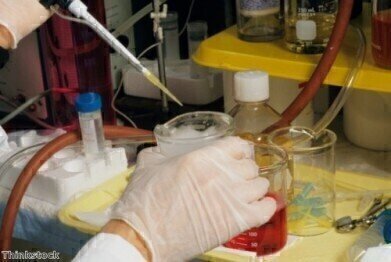-
 The HIV virus is constantly changing, which makes treatment development difficult
The HIV virus is constantly changing, which makes treatment development difficult
Bioanalytical
Synthetic protein could help with HIV vaccine development
Oct 23 2013
A new artificial protein that is coupled with a sugar molecule has been created by scientists, which mimics a part of the outer area of the HIV virus. Scientists have managed to create the protein that works in the same way as an area of HIV's outer shell, which is where antibodies are able to bind to in order to neutralise a number of different strains of the virus.
Scientists from Duke Medicine and Memorial Sloan-Kettering Cancer Center, US, published their findings in the journal 'Proceedings of the National Academy of Sciences'. The artificial protein and coupled sugar molecule could be a key factor in the development of new antibodies that could neutralise a wide variety of different HIV strains.
Antibodies that are broadly neutralising are an important factor when it comes to protecting people from different forms of the HIV virus, which are constantly changing and rendering treatments useless. According to Doctor Barton haynes, director of the Duke Human Vaccine Institute, the new protein could be vital in understanding why it is so difficult to produce antibodies that are broadly neutralising.
"By immunising with a vaccine that primarily has the desired target for the immune system, we will be able to see if the immune system is now free to make this type of response," he said.
The HIV virus has weak sections of its outer shell, called the viral envelope. These sites are protected by the virus in a number of ways that are designed to hide them. The human immune system has been found not to target these vulnerable areas and instead focuses on the tougher outer shell, with very little result.
Neutralising antibodies are designed to target the weak areas in an effort to fight the virus. However, as they often have unusual features, they can be attacked by the immune system before they affect the virus. The new protein was created to bind to the neutralising antibodies in order to better help them develop and attack the HIV virus without being eliminated by the immune system.
The protein could help lead to a more efficient vaccine for treatment against HIV as it could continue to fight the virus even when it changes its structure.
Digital Edition
Chromatography Today - Buyers' Guide 2022
October 2023
In This Edition Modern & Practical Applications - Accelerating ADC Development with Mass Spectrometry - Implementing High-Resolution Ion Mobility into Peptide Mapping Workflows Chromatogr...
View all digital editions
Events
May 05 2024 Seville, Spain
May 15 2024 Birmingham, UK
May 19 2024 Brno, Czech Republic
May 21 2024 Lagos, Nigeria
May 23 2024 Beijing, China













